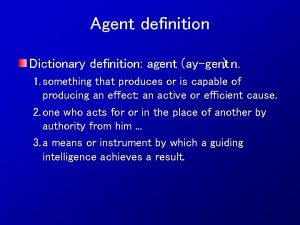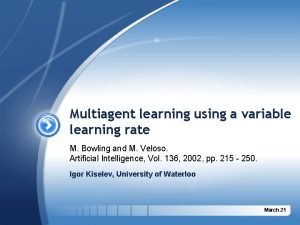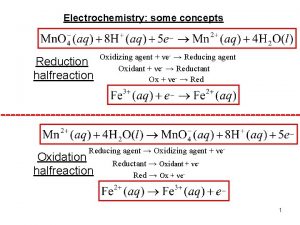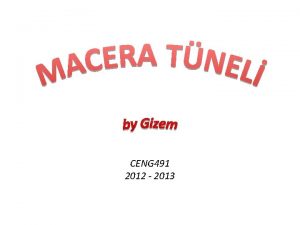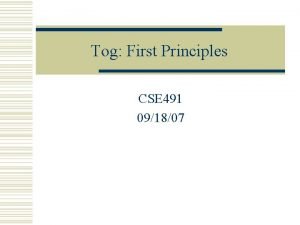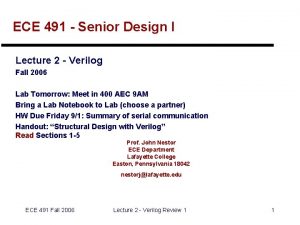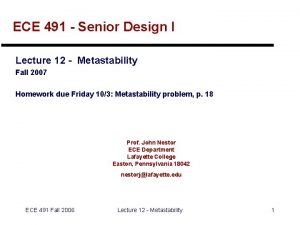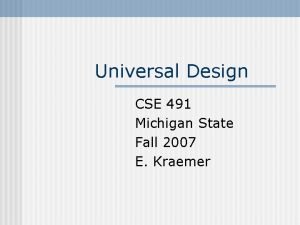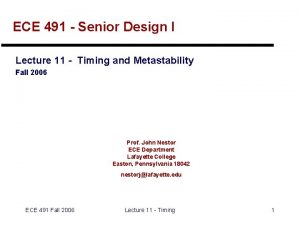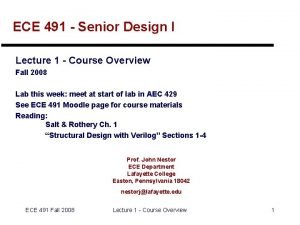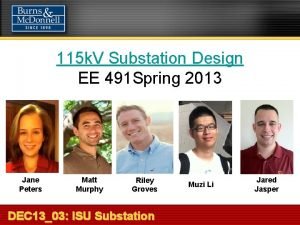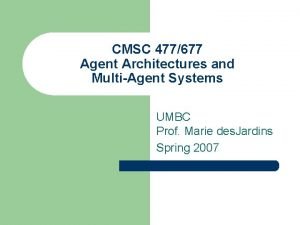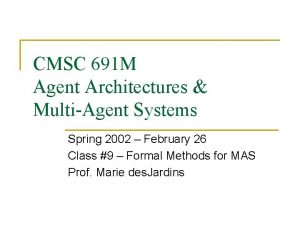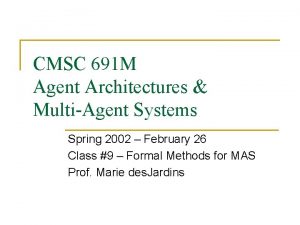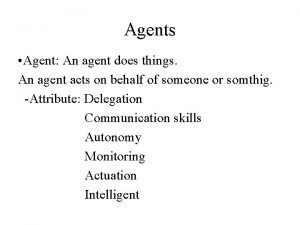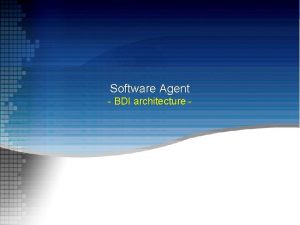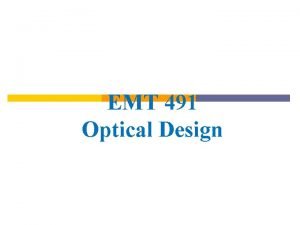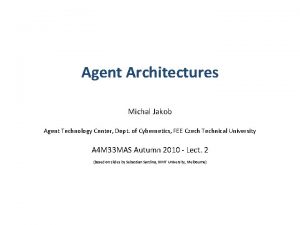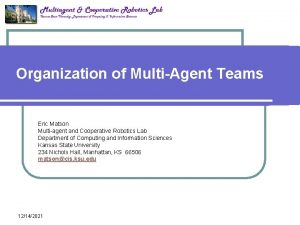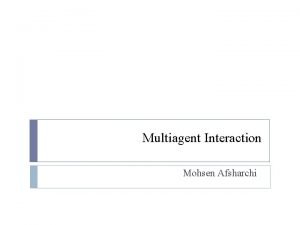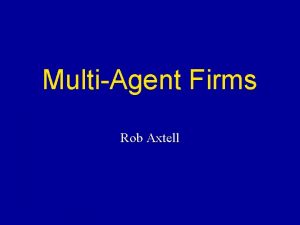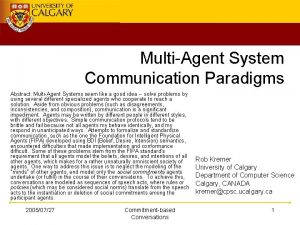CMSC 491 M691 M Agent Architectures and MultiAgent










![What’s an agent? n Weiss, p. 29 [after Wooldridge and Jennings]: q n Russell What’s an agent? n Weiss, p. 29 [after Wooldridge and Jennings]: q n Russell](https://slidetodoc.com/presentation_image_h/0c39566626b489432395dbff04b47289/image-11.jpg)







- Slides: 18

CMSC 491 M/691 M Agent Architectures and Multi-Agent Systems UMBC Prof. Marie des. Jardins Spring 2003

Course information n Prof des. Jardins q n ECS 216, x 53967, mariedj@cs. umbc. edu Class mailing list q q agents-class@listproc. umbc. edu To subscribe, send email to listproc@listproc. umbc. edu with the line: n subscribe agents-class Your Name

Today’s overview n n Class structure and policies What’s an agent? Agent exercise Next class

Class structure: Syllabus n n Course page: cmsc 691 m. html Course syllabus: schedule. html

Class structure: Participation n This is a discussion class q q n Reading must be done in advance Participation counts—a lot 45% of grade is related to class participation q Class discussion (35%) n n n q q Do you attend class? Are you prepared? Have you done the reading? Have you thought about the discussion questions? Do you contribute to the discussion with insightful questions and comments? Reading journal (5%) Discussion leaders (5%)

Class structure: Agent architecture project n Agent architecture project: 25% of grade q q n Download one of the architectures we learn about Apply the architecture to a domain of your choice Deadlines: q q q Proposal due Feb. 19 (5% of project grade) Report due Mar. 19 (70% of grade) Demonstration week of Mar. 17 (25% of grade)

Class structure: MAS paper/project n Agent architecture project: 25% of grade q n Deadlines: q q n Open-ended: Can be an implementation project or a final paper studying a topic in more depth Proposal and bibliography due Apr. 14 (10%) Draft report due May 5 (5%) Presentation on May 7 or May 12 (20%) Final report due May 16 (65%) You will also review another student’s report; this review will be worth 5% of your class grade

Policies n n Grading and academic honesty Plagiarism, citations

Plagiarism exercise n Original passage: q n I pledge allegiance to the flag of the United States of America, and to the republic for which it stands, one nation, indivisible, with liberty and justice for all. Unacceptable summary: q I promise loyalty to the United States flag, and to the country for which it stands, one nation, with freedom and fairness for all.

Plagiarism exercise II n Original passage: q n I pledge allegiance to the flag of the United States of America, and to the republic for which it stands, one nation, indivisible, with liberty and justice for all. Acceptable summary: q I promise to be loyal to the United States flag and to the USA itself: One united country that provides basic rights such as liberty and justice to all citizens.
![Whats an agent n Weiss p 29 after Wooldridge and Jennings q n Russell What’s an agent? n Weiss, p. 29 [after Wooldridge and Jennings]: q n Russell](https://slidetodoc.com/presentation_image_h/0c39566626b489432395dbff04b47289/image-11.jpg)
What’s an agent? n Weiss, p. 29 [after Wooldridge and Jennings]: q n Russell and Norvig, p. 7: q n “An agent is a computer system that is situated in some environment, and that is capable of autonomous action in this environment in order to meet its design objectives. ” “An agent is just something that perceives and acts. ” Rosenschein and Zlotkin, p. 4: q “The more complex the considerations that [a] machine takes into account, the more justified we are in considering our computer an ‘agent, ’ who acts as our surrogate in an automated encounter. ”

What’s an agent? II Ferber, p. 9: n “An agent is a physical or virtual entity q a) b) c) d) e) f) g) h) i) Which is capable of acting in an environment, Which can communicate directly with other agents, Which is driven by a set of tendencies…, Which possesses resources of its own, Which is capable of perceiving its environment…, Which has only a partial representation of this environment…, Which possesses skills and can offer services, Which may be able to reproduce itself, Whose behavior tends towards satisfying its objectives, taking account of the resources and skills available to it and depending on its perception, its representations and the communications it receives. ”

OK, so what’s an environment? n Isn’t any system that has inputs and outputs situated in an environment of sorts?

What’s autonomy, anyway? n Jennings and Wooldridge, p. 4: q n “[In contrast with objects, we] think of agents as encapsulating behavior, in addition to state. An object does not encapsulate behavior: it has no control over the execution of methods – if an object x invokes a method m on an object y, then y has no control over whether m is executed or not – it just is. In this sense, object y is not autonomous, as it has no control over its own actions…. Because of this distinction, we do not think of agents as invoking methods (actions) on agents – rather, we tend to think of them requesting actions to be performed. The decision about whether to act upon the request lies with the recipient. ” Is an if-then-else statement sufficient to create autonomy?

So now what? n If those definitions aren’t useful, is there a useful definition? Should we bother trying to create “agents” at all?

Agent exercise n Pick a card, any card…

After-action review or post-mortem, as the case may be… n n n Did the class (agent community) find a consistent solution? How many agents had an instantiation? How many constraints were violated? q n Why those ones? Any theories? What’s hard about this problem?

Next class n Reading: Weiss Prologue and Chapter 1
 Site:slidetodoc.com
Site:slidetodoc.com Multiagent learning using a variable learning rate
Multiagent learning using a variable learning rate What does an oxidizing agent do
What does an oxidizing agent do Standard potential table
Standard potential table Database storage architecture
Database storage architecture Autoencoders
Autoencoders Ba 491
Ba 491 External analysis in strategic management
External analysis in strategic management Pngpa
Pngpa Cs 491 bilkent
Cs 491 bilkent Bahri tokmak
Bahri tokmak Tog on interface
Tog on interface Ece 491
Ece 491 Mtbf formula
Mtbf formula Cse 491
Cse 491 Ece 491
Ece 491 Ece 491
Ece 491 Ee 491
Ee 491 Ee 491
Ee 491
